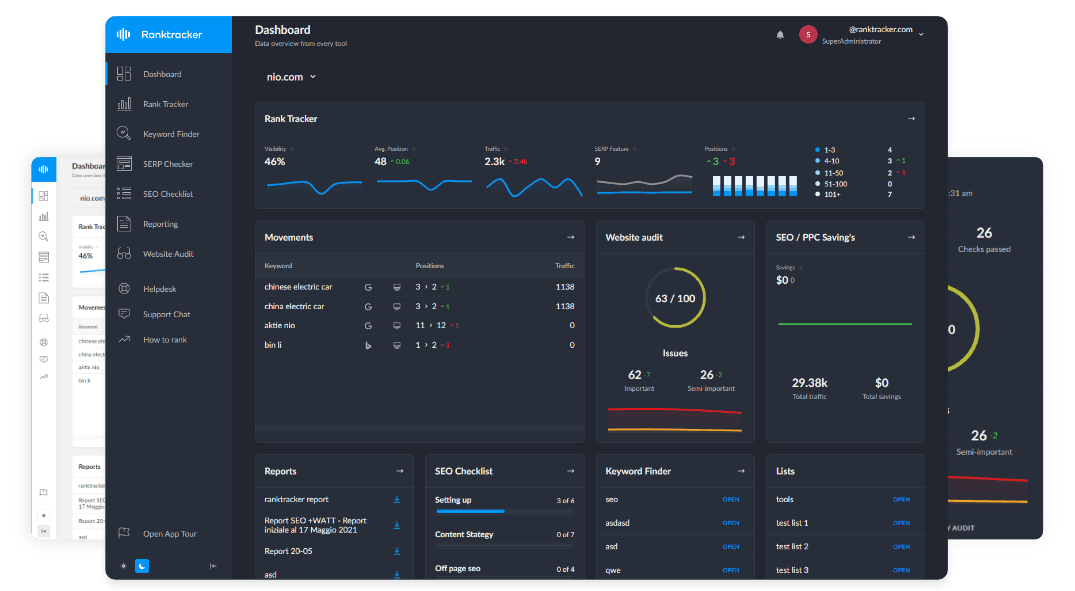Intro
Terrariums are more than decorative plant displays—they’re living art. And the people searching for them are just as diverse: from eco-conscious apartment dwellers and hobbyists to teachers, gift buyers, and DIY enthusiasts.
If your site offers terrarium kits, care tips, or supplies, you need to be visible when users search for terms like “DIY closed terrarium kit,” “moss terrarium care,” or “how to build a low-maintenance terrarium.” With the right SEO strategy and Ranktracker’s tools, your website can bloom in search results and draw in a steady stream of traffic.
Why SEO Matters for the Terrarium Niche
The terrarium niche thrives on aesthetics, how-to content, and giftability—making it perfect for organic search growth.
With effective SEO, you can:
-
Attract traffic from eco-conscious hobbyists and DIY crafters
-
Rank for seasonal gifting terms like “succulent terrarium gift set”
-
Educate users with evergreen care content
-
Increase DTC sales for your terrarium kits and supplies
-
Establish authority in the growing plant care and home decor market
Use Ranktracker’s Rank Tracker to monitor high-intent keywords like “build a closed terrarium” or “self-sustaining moss ecosystem.”
Keyword Research: Capture DIY, Decor, and Botanical Search Intent
Terrarium-related queries range from beginner guides to advanced ecosystem builds.
Use Ranktracker’s Keyword Finder to discover opportunities such as:
-
“how to make a terrarium step by step”
-
“closed terrarium for moss and ferns”
-
“succulent terrarium kit with glass jar”
-
“self-watering terrarium guide”
-
“terrarium layers explained”
-
“best plants for closed terrariums”
-
“buy tropical terrarium kit”
-
“DIY terrarium with lights”
-
“open vs closed terrarium care”
-
“how to stop mold in terrariums”
Segment keywords by:
-
Terrarium type: closed, open, succulent, tropical, moss
-
User intent: how-to, shopping, care, troubleshooting
-
Occasion: gifts, weddings, classrooms, decor
-
Skill level: beginner, hobbyist, advanced
On-Page SEO: Optimize Every Kit, Guide, and Product Page
Your site should guide users seamlessly from search to education to conversion.
On-page SEO tips:
-
Title tag: “DIY Closed Terrarium Kit – Moss Ecosystem in Glass Jar”
-
H1: “Build Your Own Self-Sustaining Moss Terrarium”
-
URL:
/kits/closed-moss-terrarium-diy/ -
Meta Description: Highlight what's included, who it’s for, and key benefits
-
Structured data: Product, HowTo, FAQ schema
-
Product Pages: Include tools, plant species, size, and care instructions
-
Internal Links: Point to guides, tools, and related terrarium types
-
Media: Add step-by-step photos and lifestyle shots
Test search visibility using Ranktracker’s SERP Simulator.
Content Marketing: Plant Authority with Educational and Visual Content
Terrarium buyers and makers are information-hungry. Educate them, and they’ll keep coming back—and sharing.
Terrarium content topics that drive traffic:
-
“Terrarium Layers Explained: A Beginner’s Guide to Drainage, Soil, and Moss”
-
“Best Plants for Closed Terrariums (And Which to Avoid)”
-
“DIY Wedding Favors: How to Make Mini Terrariums in Bulk”
-
“How to Stop Mold in a Terrarium Naturally”
-
“Succulent Terrarium vs. Tropical: Which One Fits Your Space?”
-
“Creating a Self-Sustaining Ecosystem in a Jar”
-
“Terrarium Mistakes to Avoid: Lessons from 100 Builds”
Use Ranktracker’s AI Article Writer to scale evergreen guides, listicles, and tutorials.
Technical SEO: Make Browsing and Buying Seamless
Your technical SEO should help Google and users “see” your greenery clearly.
The All-in-One Platform for Effective SEO
Behind every successful business is a strong SEO campaign. But with countless optimization tools and techniques out there to choose from, it can be hard to know where to start. Well, fear no more, cause I've got just the thing to help. Presenting the Ranktracker all-in-one platform for effective SEO
We have finally opened registration to Ranktracker absolutely free!
Create a free accountOr Sign in using your credentials
Essentials for terrarium site performance:
-
Mobile-first design with responsive galleries
-
Fast page speed for media-heavy content
-
SEO-friendly URLs like
/care/terrarium-lighting-guide/ -
Structured product categories by plant type, size, and terrarium style
-
Schema for products, reviews, FAQs, and articles
-
Alt text on every plant and tutorial image
-
Internal linking between care, product, and inspiration pages
Audit your site’s structure and speed using Ranktracker’s Web Audit.
Visual SEO: Showcase Greenery, Craftsmanship, and Process
Terrariums are visual by nature. Let every photo earn you clicks and trust.
Visual content SEO tips:
-
File names:
succulent-terrarium-gift-kit.jpg -
Alt text: “Succulent terrarium in glass bowl with white pebbles and moss”
-
Include:
-
Before/after photos of build process
-
Close-ups of layers and plant detail
-
UGC from customers’ finished kits
-
Infographics: “Anatomy of a Closed Terrarium”
-
Tutorial videos: unboxing, assembling, maintaining
-
Optimize all media with Ranktracker’s Web Audit for image size and structure.
Link Building: Get Featured by DIY Blogs, Garden Sites & Gift Guides
Backlinks help position your brand as the go-to terrarium expert.
Strategies for building links in the terrarium niche:
-
Submit projects to DIY or indoor gardening blogs
-
Collaborate with eco-conscious YouTubers or TikTok plant influencers
-
Pitch to seasonal gift guides: Mother’s Day, Christmas, housewarming
-
Get featured on sustainability, upcycling, or craft websites
-
Offer guest posts on home decor or lifestyle blogs
-
Share free care printables for teachers or event planners
Track backlinks with Ranktracker’s Backlink Monitor and prioritize high-authority referrers.
Reviews & UGC: Let Your Customers Do the Growing
Terrarium lovers often share their creations—capitalize on this to drive conversions and improve SEO.
Social proof & review strategies:
-
Collect product reviews with images
-
Repost customer builds on Instagram or blog galleries
-
Use Q&A sections to answer common kit questions
-
Run seasonal challenges: “Terrarium of the Month”
-
Ask buyers to tag your brand for discounts or reposts
-
Use testimonials in emails, landing pages, and remarketing
Monitor and manage reputation using Ranktracker’s Reputation Management tool.
SEO Checklist for Terrarium Brands & Bloggers
-
Target plant-specific, care-specific, and intent-based keywords
-
Optimize all pages for UX, search engines, and conversions
-
Build a strong library of how-to, troubleshooting, and inspiration content
-
Improve site performance and indexing with technical audits
-
Use original visuals to tell your brand story
-
Build backlinks from relevant DIY, gardening, and gift sources
-
Encourage reviews, UGC, and social sharing
-
Track every key metric using Ranktracker’s all-in-one SEO suite
Conclusion
Terrarium building is a blend of creativity, nature, and science—and your SEO strategy should reflect the same thoughtful balance. With the right content, structure, and visibility tools like Ranktracker, your brand can grow beyond social media and become a trusted authority in the green lifestyle movement. It’s time to let your website thrive—one layer, one plant, one keyword at a time.

